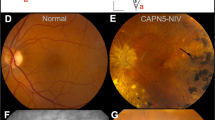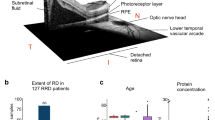Abstract
Excessive retinal vascular permeability contributes to the pathogenesis of proliferative diabetic retinopathy and diabetic macular edema, leading causes of vision loss in working-age adults. Using mass spectroscopy–based proteomics, we detected 117 proteins in human vitreous and elevated levels of extracellular carbonic anhydrase-I (CA-I) in vitreous from individuals with diabetic retinopathy, suggesting that retinal hemorrhage and erythrocyte lysis contribute to the diabetic vitreous proteome. Intravitreous injection of CA-I in rats increased retinal vessel leakage and caused intraretinal edema. CA-I–induced alkalinization of vitreous increased kallikrein activity and its generation of factor XIIa, revealing a new pathway for contact system activation. CA-I–induced retinal edema was decreased by complement 1 inhibitor, neutralizing antibody to prekallikrein and bradykinin receptor antagonism. Subdural infusion of CA-I in rats induced cerebral vascular permeability, suggesting that extracellular CA-I could have broad relevance to neurovascular edema. Inhibition of extracellular CA-I and kallikrein-mediated innate inflammation could provide new therapeutic opportunities for the treatment of hemorrhage-induced retinal and cerebral edema.
This is a preview of subscription content, access via your institution
Access options
Subscribe to this journal
Receive 12 print issues and online access
$209.00 per year
only $17.42 per issue
Buy this article
- Purchase on Springer Link
- Instant access to full article PDF
Prices may be subject to local taxes which are calculated during checkout





Similar content being viewed by others
References
Kempen, J.H. et al. The prevalence of diabetic retinopathy among adults in the United States. Arch. Ophthalmol. 122, 552–563 (2004).
Williams, R. et al. Epidemiology of diabetic retinopathy and macular oedema: a systematic review. Eye 18, 963–983 (2004).
The Diabetes Control and Complications Trial Research Group. The effect of intensive treatment of diabetes on the development and progression of long-term complications in insulin-dependent diabetes mellitus. N. Engl. J. Med. 329, 977–986 (1993).
Stratton, I.M. et al. Association of glycaemia with macrovascular and microvascular complications of type 2 diabetes (UKPDS 35): prospective observational study. Br. Med. J. 321, 405–412 (2000).
UK Prospective Diabetes Study Group. Tight blood pressure control and risk of macrovascular and microvascular complications in type 2 diabetes: UKPDS 38. Br. Med. J. 317, 703–713 (1998).
Klein, R., Klein, B.E., Moss, S.E. & Cruickshanks, K.J. The Wisconsin epidemiologic study of diabetic retinopathy: XVII. The 14-year incidence and progression of diabetic retinopathy and associated risk factors in type 1 diabetes. Ophthalmology 105, 1801–1815 (1998).
Ferris, F.L., III, Davis, M.D. & Aiello, L.M. Treatment of diabetic retinopathy. N. Engl. J. Med. 341, 667–678 (1999).
Klein, R., Klein, B.E., Moss, S.E., Davis, M.D. & DeMets, D.L. The Wisconsin epidemiologic study of diabetic retinopathy. IV. Diabetic macular edema. Ophthalmology 91, 1464–1474 (1984).
Knudsen, S.T. et al. Macular edema reflects generalized vascular hyperpermeability in type 2 diabetic patients with retinopathy. Diabetes Care 25, 2328–2334 (2002).
Krogsaa, B., Lund-Andersen, H., Mehlsen, J., Sestoft, L. & Larsen, J. The blood-retinal barrier permeability in diabetic patients. Acta Ophthalmol. (Copenh.) 59, 689–694 (1981).
Plehwe, W.E., Sleightholm, M.A. & Kohner, E.M. Does vitreous fluorophotometry reflect severity of early diabetic retinopathy? Br. J. Ophthalmol. 73, 255–260 (1989).
Lattanzio, R. et al. Macular thickness measured by optical coherence tomography (OCT) in diabetic patients. Eur. J. Ophthalmol. 12, 482–487 (2002).
Aiello, L.P. et al. Vascular endothelial growth factor in ocular fluid of patients with diabetic retinopathy and other retinal disorders. N. Engl. J. Med. 331, 1480–1487 (1994).
Ogata, N., Nishikawa, M., Nishimura, T., Mitsuma, Y. & Matsumura, M. Unbalanced vitreous levels of pigment epithelium-derived factor and vascular endothelial growth factor in diabetic retinopathy. Am. J. Ophthalmol. 134, 348–353 (2002).
Gragoudas, E.S., Adamis, A.P., Cunningham, E.T., Jr., Feinsod, M & Guyer, D.R. Pegaptanib for neovascular age-related macular degeneration. N. Engl. J. Med. 351, 2805–2816 (2004).
Srinivas, S.P., Ong, A., Zhai, C.B. & Bonanno, J.A. Inhibition of carbonic anhydrase activity in cultured bovine corneal endothelial cells by dorzolamide. Invest. Ophthalmol. Vis. Sci. 43, 3273–3278 (2002).
Wolfensberger, T.J. et al. Membrane-bound carbonic anhydrase in human retinal pigment epithelium. Invest. Ophthalmol. Vis. Sci. 35, 3401–3407 (1994).
Giusti, C., Forte, R., Vingolo, E.M. & Gargiulo, P. Is acetazolamide effective in the treatment of diabetic macular edema? A pilot study. Int. Ophthalmol. 24, 79–88 (2001).
Miyamoto, K. et al. Prevention of leukostasis and vascular leakage in streptozotocin-induced diabetic retinopathy via intercellular adhesion molecule-1 inhibition. Proc. Natl. Acad. Sci. USA 96, 10836–10841 (1999).
Wojtkowski, M. et al. Three dimensional retinal imaging with high-speed, ultrahigh resolution, optical coherence tomography. Ophthalmology 112, 1734–1746 (2005).
Anderson, N.L. et al. The human plasma proteome: a nonredundant list developed by combination of four separate sources. Mol. Cell. Proteomics 3, 311–326 (2004).
Wistrand, P.J., Schenholm, M. & Lonnerholm, G. Carbonic anhydrase isoenzymes CA I and CA II in the human eye. Invest. Ophthalmol. Vis. Sci. 27, 419–428 (1986).
Carugati, A., Pappalardo, E., Zingale, L.C. & Cicardi, M. C1-inhibitor deficiency and angioedema. Mol. Immunol. 38, 161–173 (2001).
Han, E.D., MacFarlane, R.C., Mulligan, A.N., Scafidi, J. & Davis, A.E., III. Increased vascular permeability in C1 inhibitor-deficient mice mediated by the bradykinin type 2 receptor. J. Clin. Invest. 109, 1057–1063 (2002).
Shariat-Madar, Z., Mahdi, F. & Schmaier, A.H. Identification and characterization of prolylcarboxypeptidase as an endothelial cell prekallikrein activator. J. Biol. Chem. 277, 17962–17969 (2002).
Houle, S., Molinaro, G., Adam, A. & Marceau, F. Tissue kallikrein actions at the rabbit natural or recombinant kinin B2 receptors. Hypertension 41, 611–617 (2003).
Veloso, D., Silver, L.D., Hahn, S. & Colman, R.W. A monoclonal anti-human plasma prekallikrein antibody that inhibits activation of prekallikrein by factor XIIa on a surface. Blood 70, 1053–1062 (1987).
Yang, Z. et al. Mutant carbonic anhydrase 4 impairs pH regulation and causes retinal photoreceptor degeneration. Hum. Mol. Genet. 14, 255–265 (2005).
Xi, G. et al. Mechanisms of edema formation after intracerebral hemorrhage: effects of extravasated red blood cells on blood flow and blood-brain barrier integrity. Stroke 32, 2932–2938 (2001).
Qureshi, A.I. et al. Spontaneous intracerebral hemorrhage. N. Engl. J. Med. 344, 1450–1460 (2001).
Yamane, K. et al. Proteome analysis of human vitreous proteins. Mol. Cell. Proteomics 2, 1177–1187 (2003).
Nakanishi, T., Koyama, R., Ikeda, T. & Shimizu, A. Catalogue of soluble proteins in the human vitreous humor: comparison between diabetic retinopathy and macular hole. J. Chromatogr. B Analyt. Technol. Biomed. Life Sci. 776, 89–100 (2002).
Ouchi, M., West, K., Crabb, J.W., Kinoshita, S. & Kamei, M. Proteomic analysis of vitreous from diabetic macular edema. Exp. Eye Res. 81, 176–182 (2005).
Henricsson, M., Sellman, A., Tyrberg, M. & Groop, L. Progression to proliferative retinopathy and macular oedema requiring treatment. Assessment of the alternative classification of the Wisconsin Study. Acta Ophthalmol. Scand. 77, 218–223 (1999).
Svastova, E. et al. Hypoxia activates the capacity of tumor-associated carbonic anhydrase IX to acidify extracellular pH. FEBS Lett. 577, 439–445 (2004).
Iwaki, T. & Castellino, F.J. Plasma levels of bradykinin are suppressed in factor XII-deficient mice. Thromb. Haemost. 95, 1003–1010 (2006).
Shariat-Madar, Z., Mahdi, F. & Schmaier, A.H. Recombinant prolylcarboxypeptidase activates plasma prekallikrein. Blood 103, 4554–4561 (2004).
Joseph, K. & Kaplan, A.P. Formation of bradykinin: a major contributor to the innate inflammatory response. Adv. Immunol. 86, 159–208 (2005).
Nagelhus, E.A. et al. Carbonic anhydrase XIV is enriched in specific membrane domains of retinal pigment epithelium, Muller cells, and astrocytes. Proc. Natl. Acad. Sci. USA 102, 8030–8035 (2005).
Rassam, S.M., Patel, V. & Kohner, E.M. The effect of acetazolamide on the retinal circulation. Eye 7, 697–702 (1993).
Vorstrup, S., Henriksen, L. & Paulson, O.B. Effect of acetazolamide on cerebral blood flow and cerebral metabolic rate for oxygen. J. Clin. Invest. 74, 1634–1639 (1984).
Stefansson, E. et al. Optic nerve oxygen tension in pigs and the effect of carbonic anhydrase inhibitors. Invest. Ophthalmol. Vis. Sci. 40, 2756–2761 (1999).
Weber, A. et al. Unexpected nanomolar inhibition of carbonic anhydrase by COX-2-selective celecoxib: new pharmacological opportunities due to related binding site recognition. J. Med. Chem. 47, 550–557 (2004).
van Doorn, M.B. et al. A phase I study of recombinant human C1 inhibitor in asymptomatic patients with hereditary angioedema. J. Allergy Clin. Immunol. 116, 876–883 (2005).
Kakoki, M., Takahashi, N., Jennette, J.C. & Smithies, O. Diabetic nephropathy is markedly enhanced in mice lacking the bradykinin B2 receptor. Proc. Natl. Acad. Sci. USA 101, 13302–13305 (2004).
Early Treatment Diabetic Retinopathy Study Research Group. Grading diabetic retinopathy from stereoscopic color fundus photographs–an extension of the modified Airlie House classification. ETDRS report number 10. Ophthalmology 98, 786–806 (1991).
Aiello, L.P. et al. Vascular endothelial growth factor-induced retinal permeability is mediated by protein kinase C in vivo and suppressed by an orally effective beta-isoform-selective inhibitor. Diabetes 46, 1473–1480 (1997).
Acknowledgements
We thank X. Chen and D. Bursell for technical assistance. This work was supported in part by the US National Institutes of Health (grants DK 60165, DK 36836, EY011289 and EY014106), the Juvenile Diabetes Research Foundation (1-2005-1047), the Massachusetts Lions Eye Research Fund, the Adler Foundation and the Air Force Office of Scientific Research Medical Free Electron Laser Program (FA9550-040-1-0046).
Author information
Authors and Affiliations
Contributions
B.-B.G. conducted the proteomic and bioinformatic analysis; performed all western blot and in vitro enzymatic analyses, and cerebral vascular permeability experiments; and contributed to manuscript writing. A.C. and S.-E.B. performed retinal permeability analyses, intravitreal injections, and vitreous pH analyses; and assisted in designing the in vivo experiments. S.R. assisted with retinal permeability experiments and coordinated vitreous collection. S.J.F. performed proteome statistical analysis and assisted in editing the manuscript. V.S., M.W. and J.G.F. conducted the OCT measurements, and analyzed and interpreted the results. R.L.A. and P.G.A. provided vitreous samples and conducted the clinical diagnoses. L.P.A. provided vitreous samples and clinical information, and contributed to manuscript writing. E.P.F. designed the entire study, supervised all components of the study, and wrote the manuscript.
Corresponding author
Ethics declarations
Competing interests
J.G.F. receives royalties from intellectual property licensed by MIT to Carl Zeiss Meditec and LightLab Imaging. E.P.F. and L.P.A. have a pending patent application that includes data from this report.
Supplementary information
Supplementary Fig. 1
Effect of C1-INH on PK activation by FXII in the presence of HK. Kallikrein activity was measured as cleavage of synthetic fluorogenic kallikrein substrate (0.4 mM) on a microplate reader at 37 °C at 15 min. (PDF 23 kb)
Supplementary Fig. 2
Effect of anti-PK antibody on PK activation by FXII in the presence of HK. (PDF 22 kb)
Supplementary Fig. 3
Effect of pH, CA-I and HCO3− on PK activation by FXII in the presence of HK. (PDF 16 kb)
Supplementary Fig. 4
Effect of pH on PK activation by FXII in the presence of HK. **P < 0.01 vs pH 7.4. (PDF 17 kb)
Supplementary Fig. 5
Effect of pH on FXII autoactivation in the absence of PK and HK. (PDF 14 kb)
Supplementary Table 1
Demographics of Study Subjects (PDF 31 kb)
Supplementary Table 2
Vitreous proteome in individuals with NDM, noDR or PDR (PDF 317 kb)
Rights and permissions
About this article
Cite this article
Gao, BB., Clermont, A., Rook, S. et al. Extracellular carbonic anhydrase mediates hemorrhagic retinal and cerebral vascular permeability through prekallikrein activation. Nat Med 13, 181–188 (2007). https://doi.org/10.1038/nm1534
Received:
Accepted:
Published:
Issue Date:
DOI: https://doi.org/10.1038/nm1534
This article is cited by
-
The effect of combination therapy with intravitreal bevacizumab and topical timolol–dorzolamide eye drops on diabetic macular edema: a double-blind randomized controlled trial
International Ophthalmology (2024)
-
Simulating Cerebral Edema and Ischemia After Traumatic Acute Subdural Hematoma Using Triphasic Swelling Biomechanics
Annals of Biomedical Engineering (2024)
-
Vitreous humor proteome: unraveling the molecular mechanisms underlying proliferative and neovascular vitreoretinal diseases
Cellular and Molecular Life Sciences (2023)
-
A validated analysis pipeline for mass spectrometry-based vitreous proteomics: new insights into proliferative diabetic retinopathy
Clinical Proteomics (2021)
-
Current understanding of the molecular and cellular pathology of diabetic retinopathy
Nature Reviews Endocrinology (2021)



